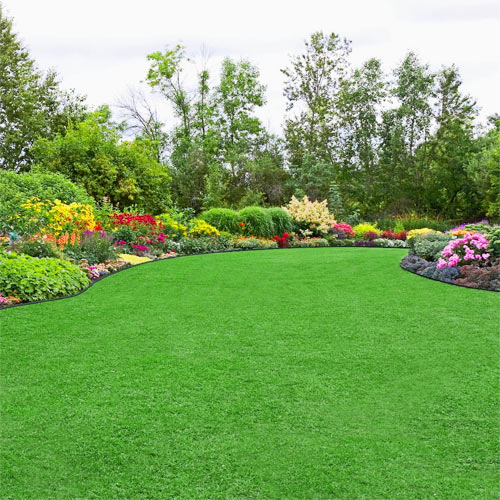Burlington County NJ Area Landscape, Lawn Care, Site Development
Jefferson Bldg, Ste 520
Cinnaminson, NJ 08077
| Mon-Fri | 8:00am - 6:00pm |
| Saturday | 8:00am - 12:00pm |
| Sunday | Closed |
| 24/7 EMERGENCY SERVICES | |
| Mon-Fri | 8:00am - 6:00pm |
| Saturday | 8:00am - 12:00pm |
| Sunday | Closed |
| 24/7 EMERGENCY SERVICES | |

Grass thrives when it's mowed at the proper height and frequency. Regular trimming prevents overgrowth, encourages uniform growth, and strengthens roots. Cutting your lawn too infrequently can lead to an overgrown, patchy, or unhealthy yard that invites pests and fungal diseases like brown patch, dollar spot, and red thread. Regular mowing, combined with proper aeration and fertilization, helps mitigate these risks by improving airflow, reducing moisture buildup, and strengthening the grass's resistance to infestations and infections.
A well-maintained lawn leaves little room for invasive weeds to take over. Mowing at the correct height ensures that your grass stays strong enough to outcompete weeds. Additionally, regular cutting helps detect potential pest infestations such as grubs, chinch bugs, and sod webworms, which feed on grass roots and cause brown patches. A strict maintenance schedule will show early signs of pests and weed invasions before they become a costly problem.
For homeowners, a neatly trimmed lawn improves property value and neighborhood aesthetics. A manicured lawn, free of overgrown grass and weeds, complements landscaping features such as flower beds, walkways, and outdoor seating areas, making the entire property more visually appealing. A well-maintained yard can also enhance seasonal outdoor gatherings. For businesses, first impressions are crucial. A lush, green lawn with sharp edges and professional landscaping shows customers and clients that you care about your business's image. An unkempt property can deter visitors, while a pristine outdoor space can encourage foot traffic, boost morale among employees, and set a high standard for professionalism.
Routine mowing keeps your lawn thick and healthy by removing dead grass and promoting new growth. Frequent mowing helps improve light penetration and air circulation, which are critical for photosynthesis and overall plant health. Cutting grass regularly also prevents disease by eliminating weak or damaged blades that can harbor fungi or bacteria. When done at the appropriate height, mowing encourages stronger root development, leading to a more resilient and drought-tolerant lawn. Over time, a well-maintained lawn will develop a denser turf, which naturally crowds out weeds and reduces the need for chemical treatments.
Lawn care involves more than just cutting grass. Comprehensive grass maintenance is essential for a truly healthy and vibrant lawn. The ongoing care and management of grass-covered areas ensures their health, vitality, and visual appeal. This includes regular mowing, aeration, fertilization, weed and pest control, irrigation, overseeding, dethatching, and seasonal cleanups. Proper grass maintenance enhances lawn resilience, promotes dense and even grass growth, prevents disease, and improves soil health, ultimately resulting in a lush, green, and thriving landscape. Here are some key components of a strong grass maintenance plan:
Over time, soil compaction can prevent air, water, and nutrients from reaching grass roots. Aeration—punching small holes in the soil—allows these vital elements to penetrate, promoting deeper root growth. Overseeding, or the process of spreading grass seed over an existing lawn will improve its density, fill in bare patches, and enhance its overall health. It can also introduce newer, more resilient grass varieties that can better withstand drought, disease, and heavy foot traffic. Overseeding after aeration helps thicken the lawn, filling in bare spots and improving resistance to disease.
Healthy soil is the foundation of a great lawn. Applying the right mix of fertilizers at the correct times ensures your grass gets the nutrients it needs to flourish. Soil testing can determine pH levels and deficiencies, allowing for precise treatment. Proper fertilization provides essential nutrients such as nitrogen, phosphorus, and potassium, which promote strong root development, vibrant green color, and resistance to disease. Regular fertilization enhances microbial activity in the soil, supporting beneficial organisms that break down organic matter and enrich the turf. When paired with aeration and proper irrigation, fertilization leads to a healthier, more resilient lawn capable of withstanding environmental stresses like drought, extreme temperatures, and heavy foot traffic.
Spring and fall cleanups help remove leaves, debris, and thatch buildup that can suffocate your lawn. Thatch—a layer of organic material that sits on top of the soil—can prevent water absorption and lead to disease if not properly managed. During seasonal cleanups, accumulated organic matter is cleared away to promote proper airflow and water penetration. Dethatching removes excessive thatch, preventing root suffocation and reducing the risk of fungal diseases. This process improves the efficiency of fertilizers and irrigation, ensuring nutrients reach the root zone. Seasonal cleanups also prepare your lawn for extreme weather conditions, making it more resilient to summer heat or winter frost.
Proper hydration is essential for any lawn. Overwatering can lead to fungus, while underwatering can cause dry, brittle grass. Smart irrigation systems or well-timed watering schedules help maintain the perfect balance for your lawn's needs. Drip irrigation and soaker hoses can efficiently deliver water directly to the root zone, reducing waste and evaporation. An efficient watering schedule prevents fungal growth while allowing moisture to penetrate the soil.

NJ Home Improvement License #13VH07367300
| HOURS | |
| Mon-Fri | 8:00am - 6:00pm |
| Saturday | 8:00am - 12:00pm |
| Sunday | Closed |
| 24/7 EMERGENCY SERVICES | |
Kurt's Complete
Jefferson Bldg, Ste 520
Cinnaminson, NJ 08077